
places it was procured by Mr. Prank Oates, who also fell in with it
on the Mariko River. Mr. Andersson observes: “ This bird is
found most abundantly throughout Damara and Great Namaqua
Land, in the valleys of the Okavango and of the Teoughe, and in
the Lake regions. Like our European Starling, which it very much
resembles in manners and habits, it frequently congregates in large
flocks; it is comparatively tame and easy to approach, and is often
met with near villages. Its food is very various, consisting of
berries, seeds, and insects, and it is very destructive to fruit-gardens ;
its flesh is not unpalatable. This species forms its nest in the
hollows of trees, lining the cavity well with feathers. The eggs are
four in number, of a long oval shape, but tapering much more at
one end than at the other; they are of a pale bluish-green, spotted
all over with small dots of light brown.
Professor Barboza du Bocage is of opinion that the species from
Damara Land and Benguela is distinct from the ordinary L. phceni-
copterus and should be recognized as L. Uspecularis of Strickland
and Sclater. We may not have seen the species intended by
Bocage, but, as far as our own observations go, we think Mr. Gurney
is right in considering the Damara birds to be the same as the
ordinary Cape Glossy Starling.
Mr. Monteiro procured it in Benguela, and says it is common all
over Angola. The L. decoratus of Hartlaub we believe to be the
same as L. phoenicopterus, and Juida av/rata of our first edition
(p. 171) is also the same bird.
Sea-green, glossed with blue on the head, rump, tail, and thighs,
and with violet on the ears; shoulder covers greenish-blue, margined
by a flame-coloured and violet band; inner webs of the primaries
with a central notch. Length, 9" &" ; wing, 5" 4"' ; tail, 4" 2r".
Mr. Andersson gives the soft parts as follows:—“ The iris is
bright reddish-orange, the bill, legs, and toes more or less black.”
Fig. |Le Vaill. Ois. d’Afr. pi. 89.
407. L amprocolius sycobius, Peters. Peters' Glossy Starling.
Although very closely allied to L. phoenicopterus the present
species differs in being a much smaller bird and in having the colour
of the head of a brilliant metallic oily-green colour, almost coppery
in hue, and in wanting the steel-blue gloss on the nape and crown.
Mr. Ayres, too, who procured it in the Mashoona country during
Mr. Jameson's expedition, states that the note is different. It
occurs in the Zambesi region, and extends up the east coast of
Africa. Senor Anchieta has also procured it at Humbe on the
Cunene River, as well as at Huilla and Gambos. Professor Bocage
has likewise included the North-east African L. chalybeus as being
found in Benguela, but in his latest work he has referred the
specimen to L. sycobius. _
Total length, 8‘4 inches; culmen, 0‘95; wmg, 4‘9 ; tail, 3-5; tarsus,
1-25.
408. L amprocolius acuticaudus, Bocage. Sharp-tailed Glossy Thrush.
This is --another of Senor Anchieta’s discoveries in Southern
Angola, where he found it at Huilla and Oaconda. It is closely allied
to L. phoenicopterus, but differs in the form of its tail, the dark ashy
grey colour of the under surface of the quills, and other minor
particulars.
The following description is translated from Professor Barboza
du Bocage:—
B r i l l i a n t greenish-gold; the ear-coverts steel-blue; a scapular spot
of violet-purple with a coppery gloss : median wmg-coverts marked
at the tip with a small satiny black spot; under wing-coverts black
spotted with violet; primary quills and secondaries blackish above,
brilliant green at the tip and on the outer web, underneath ashy;
the tail elongated and graduated, uniform with the back on the
upper surface, and conspicuously banded under certain lights,
blackish on the under surface; bill slender and black, as also the
feet; iris orange-yellow. Total length, 9'9 inches; wing, 5'05;
tail, 4-25; bill, 0'85; tarsus, 1T5.
Fig. Bocage, Orn. Angola, pi. vi.
409. L amprocolius n it e n s , L. Angolan Glossy Starling.
This West African species just strays within our limits in Southwestern
Africa, having been met with by Senor Anchieta at
Oapangombe in Benguela.
Brilliant metallic green; some of the lesser wing-coverts having a
rather large violet-blue spot; quills and tail-feathers blackish underneath
; under wing-coverts tinged externally and at the tip with